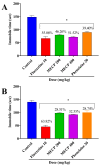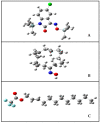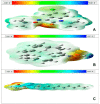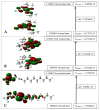Biological Evaluation, DFT Calculations and Molecular Docking Studies on the Antidepressant and Cytotoxicity Activities of Cycas pectinata Buch.-Ham. Compounds
- PMID: 32899148
- PMCID: PMC7557754
- DOI: 10.3390/ph13090232
Biological Evaluation, DFT Calculations and Molecular Docking Studies on the Antidepressant and Cytotoxicity Activities of Cycas pectinata Buch.-Ham. Compounds
Abstract
Cycas pectinata Buch.-Ham. is commonly used in folk medicine against various disorders. The present study investigated the antidepressant and cytotoxicity activity of methanol extract of C. pectinata (MECP) along with quantitative phytochemical analysis by GC-MS method. Here, the GC-MS study of MECP presented 41 compounds, among which most were fatty acids, esters, terpenoids and oximes. The antidepressant activity was assessed by the forced swimming test (FST) and tail suspension test (TST) models. In contrast, MECP (200 and 400 mg/kg) exhibited a significant and dose-dependent manner reduction in immobility comparable with fluoxetine (10 mg/kg) and phenelzine (20 mg/kg). MECP showed a weak toxicity level in the brine shrimp lethality bioassay (ED50: 358.65 µg/mL) comparable to the standard drug vincristine sulfate (ED50: 2.39 µg/mL). Three compounds from the GC-MS study were subjected to density functional theory (DFT) calculations, where only cyclopentadecanone oxime showed positive and negative active binding sites. Cyclopentadecanone oxime also showed a good binding interaction in suppressing depression disorders by blocking monoamine oxidase and serotonin receptors with better pharmacokinetic and toxicological properties. Overall, the MECP exhibited a significant antidepressant activity with moderate toxicity, which required further advance studies to identify the mechanism.
Keywords: Cycas pectinata; DFT calculations; MAO; antidepressant; cyclopentadecanone; cytotoxicity; molecular docking; oxime; oximes; serotonin.
Conflict of interest statement
The authors declare no conflict of interest.
Figures





Similar articles
-
Phytochemical analysis, in silico study and toxicity profile of Cycas pectinata Buch.-Ham seed in mice.Drug Chem Toxicol. 2023 Mar;46(2):330-342. doi: 10.1080/01480545.2022.2033258. Epub 2022 Feb 3. Drug Chem Toxicol. 2023. PMID: 35114863
-
Chemical profiles, pharmacological properties, and in silico studies provide new insights on Cycas pectinata.Heliyon. 2020 Jun 4;6(6):e04061. doi: 10.1016/j.heliyon.2020.e04061. eCollection 2020 Jun. Heliyon. 2020. PMID: 32529070 Free PMC article.
-
Antidepressant-Like Activities of Hispidol and Decursin in Mice and Analysis of Neurotransmitter Monoamines.Neurochem Res. 2020 Aug;45(8):1930-1940. doi: 10.1007/s11064-020-03057-4. Epub 2020 May 21. Neurochem Res. 2020. PMID: 32440903
-
Antidepressant-like activity of the adenosine A(2A) receptor antagonist, istradefylline (KW-6002), in the forced swim test and the tail suspension test in rodents.Pharmacol Biochem Behav. 2013 Dec;114-115:23-30. doi: 10.1016/j.pbb.2013.10.022. Epub 2013 Nov 4. Pharmacol Biochem Behav. 2013. PMID: 24201052
-
Contribution of serotonergic and nitrergic pathways, as well as monoamine oxidase-a and Na+, K+-ATPase enzymes in antidepressant-like action of ((4-tert-butylcyclohexylidene) methyl) (4-methoxystyryl) sulfide (BMMS).Metab Brain Dis. 2019 Oct;34(5):1313-1324. doi: 10.1007/s11011-019-00436-x. Epub 2019 Jun 8. Metab Brain Dis. 2019. PMID: 31177357
Cited by
-
Chemical Profiles and Pharmacological Properties with in Silico Studies on Elatostema papillosum Wedd.Molecules. 2021 Feb 4;26(4):809. doi: 10.3390/molecules26040809. Molecules. 2021. PMID: 33557235 Free PMC article.
-
Phyto-pharmacological evaluation and characterization of the methanolic extract of the Baccaurea motleyana Müll. Arg. seed: promising insights into its therapeutic uses.Front Pharmacol. 2024 Feb 29;15:1359815. doi: 10.3389/fphar.2024.1359815. eCollection 2024. Front Pharmacol. 2024. PMID: 38487168 Free PMC article.
-
Chemical Profiling, Pharmacological Insights and In Silico Studies of Methanol Seed Extract of Sterculia foetida.Plants (Basel). 2021 Jun 3;10(6):1135. doi: 10.3390/plants10061135. Plants (Basel). 2021. PMID: 34205007 Free PMC article.
-
Pectin: A Bioactive Food Polysaccharide with Cancer Preventive Potential.Molecules. 2022 Oct 31;27(21):7405. doi: 10.3390/molecules27217405. Molecules. 2022. PMID: 36364232 Free PMC article. Review.
-
Ultrasonic-induced synthesis of novel diverse arylidenes via Knoevenagel condensation reaction. Antitumor, QSAR, docking and DFT assessment.RSC Adv. 2023 Oct 10;13(42):29749-29767. doi: 10.1039/d3ra05799b. eCollection 2023 Oct 4. RSC Adv. 2023. PMID: 37822658 Free PMC article.
References
-
- Rosenbaum D., Hagen K., Deppermann S., Kroczek A.M., Haeussinger F.B., Heinzel S., Berg D., Fallgatter A.J., Metzger F.G., Ehlis A.-C. State-dependent altered connectivity in late-life depression: A functional near-infrared spectroscopy study. Neurobiol. Aging. 2016;39:57–68. doi: 10.1016/j.neurobiolaging.2015.11.022. - DOI - PubMed
LinkOut - more resources
Full Text Sources
Miscellaneous

